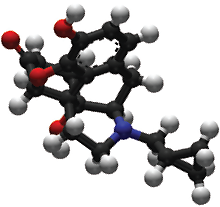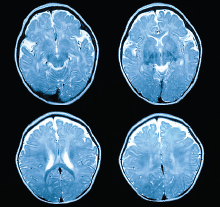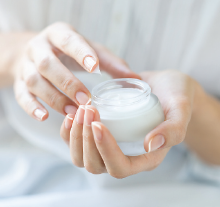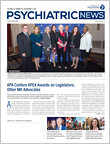Extended-Release Naltrexone Found as Effective, Safe as Buprenorphine-Naloxone
Treatment with extended-release naltrexone appears to be as safe and effective as daily oral buprenorphine-naloxone in maintaining short-term abstinence from heroin and other illicit substances in newly detoxified individuals, according to a study in JAMA Psychiatry. The findings were based on a 12-week, multicenter, outpatient, open-label trial conducted at five addiction clinics in Norway.
After detoxification, 159 opioid-dependent adults (according to DSM-IV) were randomly assigned to either daily oral, flexible dose buprenorphine-naloxone (4 mg/d to 24 mg/d) or extended-release naltrexone hydrochloride (380 mg, administered intramuscularly every fourth week) for 12 weeks. At the start of the trial and again at 4, 8, and 12 weeks, patients underwent a structured interview using the European version of the Addiction Severity Index covering drug use, physical and mental health, work, education, and criminal activity.
Treatment with extended-release naltrexone was found to be as effective as buprenorphine-naloxone at maintaining retention in treatment (mean number of days until dropout from study medication: 69.3 days and 63.7 days of 84 days, respectively).
Participants receiving extended-release naltrexone reported significantly less heroin craving and thoughts about heroin than did buprenorphine-naloxone participants, as well as greater treatment satisfaction. Individuals in the extended-release naltrexone group reported more adverse events than those in the buprenorphine-naloxone group (49 [69.0%] vs. 25 [34.7%]).
“Maintaining short-term opioid abstinence with extended-release naltrexone should be considered an equal treatment alternative to buprenorphine-naloxone as medication-assisted treatment for opioid-dependent individuals,” Lars Tanum, M.D., D.M.Sc., of the University of Oslo in Norway and colleagues wrote.
Concussion Symptoms Last Longer in Female Adolescent Athletes
A study in The Journal of the American Osteopathic Association has found that concussion symptoms last over twice as long in female athletes aged 11 to 18 as similarly aged male athletes—28 days compared with 11. In addition, 75 percent of males in the study recovered from concussion within three weeks compared with 42 percent of girls.
Researchers at Cooper University Hospital in Camden, N.J., and colleagues analyzed the medical records of 110 male and 102 female athletes with a first-time concussion diagnosis.
When looking at adolescent girls and boys separately, the investigators found no statistically significant differences in the length of reported symptoms when comparing middle school and high school athletes; they also found no statistically significant differences between sports played and symptom length.
The study authors noted that the reasons for these sex differences are likely multifaceted, including biochemical and biological differences between the two groups
“Mental stress could certainly play a role in concussion recovery, and adolescent girls may have higher levels of stress than boys,” the authors wrote.
Researchers Develop Portable Brain Scanner For Infants
Researchers at the Robert Debre University Hospital in Paris have devised a portable, noninvasive scanner that can reliably measure real-time brain activity in newborns at the bedside. Their work was published in Science Translational Medicine.
The custom-designed device combines a video-electroencephalography (EEG) recording with simultaneous Doppler ultrasound imaging of brain blood vessels. The resultant scans are known as functional ultrasound imaging (fUSI).
The research group tested their scanner in six healthy newborns and found that it could distinguish between quiet and active sleep periods. The researchers also used the device to monitor brain activity in two infants with drug-resistant seizure disorders, and could track the neurovascular changes during an episode to identify where the seizures originated. They did not observe any discomfort in the infants from wearing the customized headmount that contained the probes.
“Although further technical improvements are still needed, fUSI may be an appropriate strategy to assess brain integrity in clinical trials testing neuroprotective treatments,” the authors wrote.
“Assessing functional brain connectivity of newborns during the resting state fUSI at the bedside could provide new information about regional or global brain injury. The resolution of fUSI could also be of benefit for intraoperative functional brain imaging or for cortical mapping during brain surgery or epileptic foci localization.”
Patients May Anticipate More Side Effects When Taking Pricier Medications
Patients receiving a placebo treatment for pain relief report more severe side effects when the placebo is labeled as being expensive, according to new research published in Science. These findings shed new light on the nocebo effect, wherein clinical trial participants experience adverse outcomes even though they are not taking any active medications.
Researchers at University Medical Center Hamburg in Germany recruited 49 adults for a trial testing an anti-itch cream. Half the participants were told that that the cream was cheap, while the other half were told it was expensive. All the participants were then informed that increased pain sensitivity could be a side effect of the cream; however, in truth, there was no active ingredient in the medication.
At follow-up visits, participants were given heat patches on cream-treated skin to test the pain response. The people in the “expensive cream” group reported higher pain sensitivity than those in the cheap group, and interestingly, their sensitivity increased slightly at each subsequent visit.
During the pain assessments, the participants underwent functional MRI scanning. Participants who thought they had received the “expensive” cream and had a heightened pain response had more activity in the prefrontal cortex. Spinal cord regions associated with pain response also showed more activation in the “expensive” cream group. “In summary, we show that expensive medication increases the risk for developing nocebo-related side effects,” the authors wrote. ■




